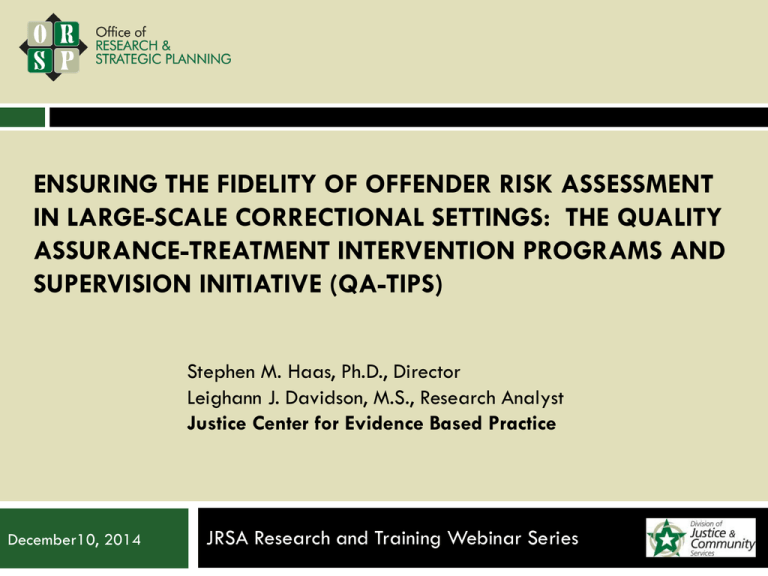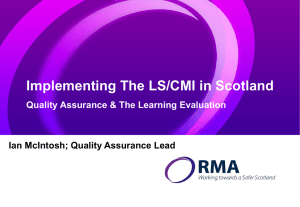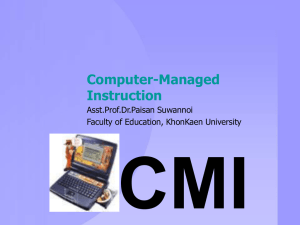qa-tips - Justice Research and Statistics Association
advertisement

ENSURING THE FIDELITY OF OFFENDER RISK ASSESSMENT IN LARGE-SCALE CORRECTIONAL SETTINGS: THE QUALITY ASSURANCE-TREATMENT INTERVENTION PROGRAMS AND SUPERVISION INITIATIVE (QA-TIPS) Stephen M. Haas, Ph.D., Director Leighann J. Davidson, M.S., Research Analyst Justice Center for Evidence Based Practice December10, 2014 JRSA Research and Training Webinar Series Webinar Moderator/discussant: J. Stephen Wormith, Ph.D., Director Co-developer, Level of Service/Case Management Inventory Centre for Forensic Behavioural Science and Justice Studies University of Saskatchewan Overview: Purpose and goals Describe WV’s Statewide Implementation of the LS/CMI Highlight the importance of assessing the accuracy of offender assessment and the quality of case plans and interviews Discuss the challenge of monitoring RNR adherence and best practices in large-scale implementations Illustrate WV’s approach for monitoring the quality assessment of offenders, and generating feedback to the field Peer-to-peer approach with supervisory oversight Electronic submissions from the field Feedback loop to the field offering information on agency and individual performance, with comparison to state and other agency/facility performance WV Office of Research and Strategic Planning (ORSP) Comprised of two units: Criminal Justice Statistical Analysis Centers Justice Center for Evidence Based Practice Criminal Justice Statistical Analysis Center (CJSAC) Collect, analyze, and disseminate justice data in WV Contribute to effective state policy through statistical services, research, evaluation, and policy analysis Provides data for sound policy and practical decisions for the justice system WV Office of Research and Strategic Planning (ORSP) Justice Center for Evidence Based Practice (JCEBP) Synthesize current research on EBP, translate to policymakers and system administrators Aide in the development of a comprehensive, statewide strategic plan aligned with EBP Services related to Level of Service/Case Management Inventory (LS/CMI) Ensure LS/CMI is implemented properly across the justice system Establish minimum standards for training and certification Develop quality assurance policies/procedures in conjunction with programs/agencies Manage online LS/CMI – data and access JCEBP: Statewide Implementation Activities Conduct LS/CMI User and User Trainer workshops Manage LS/CMI certification database and processes Develop policy/procedures and monitor for quality assurance Manage LS/CMI online system and accounts Manage on Online Learning Management System (OLMS) Develop courses on EBP and effective correctional practices Conduct Motivational Interviewing User and Trainer workshops WV Statewide LS/CMI Implementation Applied in WV for several years: Day report centers since 2006 DJS since 2008 DOC since 2010 (parole 2011) Probation and drug courts (2013) Tool is used by all sectors of the justice system, and help to inform front-end and back-end decisions! Can help to resolve offender “sorting” issue, and improve offender outcomes. Importance of Offender Assessment Purpose: To promote public safety through the accurate assessment of offender level of risk for reoffending and criminogenic needs (i.e., dynamic risk factors associated with the likelihood of reoffending, if not addressed). Research consistently shows that objective, actuarial assessment tools are better than clinical judgment alone in making case management decisions. Without assessment, cannot adhere to “what works” in offender management or evidence-based sentencing practices – ASSESSMENT IS FIRST STEP TOWARD ACHIEVING EBP AND EFFECTIVE INTEVENTIONS! Importance of “Risk Assessment” Accuracy Inaccurate risk scores WILL negatively impact decision-making throughout the system; AND result in invalid information being shared across agencies via the LS/CMI Online System Falsely high risk score = violates risk principle, diminishing impact on recidivism, has potential impact on civil liberties, wastes resources, jeopardizes public safety Falsely low risk scores = violates risk principle, results in poor targeting of risk factors diminishing impact on recidivism, and jeopardizes public safety Large-Scale Implementation and Effect Sizes Meta-analytic reviews of the offender rehabilitation literature have consistently demonstrated that treatment can reduce recidivism. The majority of the treatment programs in these reviews consist of small-scale demonstration projects (N < 100). Larger interventions, although effective in reducing recidivism, do not produce as robust effects as the smaller demonstration projects. The reasons for this may have to do more with quality implementation issues rather than with the treatment itself. Bonta, J., Bourgon, G., Rugge, T., Gress, C., Gutierrez, L. (2013). Taking the Leap: From Pilot Project to Wide-Scale Implementation of the Strategic Training Initiative in Community Supervision (STICS). Justice Research and Policy,15, 17-36. Challenges of Statewide Implementation in WV Multiple agencies and hundreds of users Division of Juvenile Services; Division of Corrections, Parole Services, Adult and Juvenile Day Report Centers, Bureau for Behavioral Health and Health Facilities, and private treatment providers. Need for minimum standards or guidance, with standardized procedures Direct observation by ORSP/JCEBP not practical/feasible ORSP/JCEBP is an “external agency” with QA oversight responsibilities for other agencies Various sources of “resistance” to new assessment and quality assurance procedures Multiple Methods for Assessing Risk Assessment Quality and WV’s Approach Multiple, valid methods for monitoring assessment quality Assessment Checklist/Matrices, Random Case Assessment/File Reviews, Taped/Video Interview Critiques, etc. WV’s approach: Peer-to-peer assessments, with supervisory oversight Intended to be “bottom-up” rather than “top-down” Effort to create “culture of quality or learning” Designed to minimize resistance, and create ownership over the quality of assessments, case plans, and interviews WV’s Statewide QA Infrastructure Statewide policies, procedures, and data collection infrastructure are in place to ensure the quality use of the LS/CMI. Goal: To create confidence among all decision-makers that LS/CMI results are accurate, assessors are qualified, and ample oversight is in place. Involves a series of quality checks Statewide certification and recertification standards An electronic system of monitoring/reporting QA results on a statewide basis Efficient and reliable sharing of assessment information via the LS/CMI Online System Quality Assurance Treatment Intervention Programs & Supervision (QA-TIPS) All Users and Trainers are adhering to statewide minimum standards Policies have statewide coverage, and do not apply to a single agency, to ensure consistency in professional standards, scoring accuracy, and valid data input into the LS/CMI Online System LS/CMI User and User Trainer Certification LS/CMI Online Security Policy LS/CMI Quality Assurance Standards and Procedures Policy LS/CMI User and User Trainer Certification Requirements Certification table LS/CMI User and User Trainer Recertification Requirements Recertification table QA-TIPS: Four LS/CMI-Related Priority Areas 1) Quality of instrument completion 2) Quality of case management plan Quantitative measure assessment accuracy Inter-rater reliability assessments Congruence between assessment and case plans Quantitative measure for supervision/treatment matching, intervention goals, and activities 3)Motivational interviewing and 4) Relationship skills Target skill balance/active listening skills Use of core correctional supervision practices Quality versus Quantity in Performance Monitoring Quality = how well?; Quantity = how many? Field is supplied with examples of over-reliance on quantity measures over quality, which results in a lack of understanding for why programs fail to achieve goals Examples: 1. 2. Quantity = Percentage of clients that received an LS/CMI Assessment; Quality = Percentage of inter-rater agreement in LS/CMI item, domain, and total risk scores Quantity = Percentage of staff who submit MI audio tapes for review and feedback; Quality = Percentage of staff who achieve “proficiency” in MI skills (based on MITI 3.1) QA-TIPS Policies and Procedures Centered on peer-to-peer, with supervisor oversight Provides immediate feedback and training to the Reviewed User as well as the Reviewer. Helps to identify service needs and training gaps at facility and state level Each LS/CMI certified User must undergo inter-rater reliability, case plan, and MI review twice per year (due June 30th and December 31st), but can be submitted at any time in each 6 month window Relationship skills are assessed once a year by LS/CMI certified supervisor during annual employee appraisal and submitted accordingly Specific Procedure: Peer-to-Peer Reviews 1. 2. 3. 4. 5. 6. 7. 8. 9. Reviewed User collects collateral information and schedules an interview The Reviewed User conducts an LS/CMI interview with the Reviewer present, and/or records (audio or video) the interview The Reviewer and Reviewed User score the assessment independently and the Reviewer completes the Assessment Review Form The Reviewer and Reviewed User review independent results and reconcile any discrepancies The Reviewed User enters the “agreed upon” LS/CMI in the Online System as official assessment The Reviewed User shares the results with the offender, creates the case plan The Reviewer completes the Case Management Review form and MI form independently and reconciles discrepancies with the Reviewed User The Reviewer submits the all three forms to the JCEBP via the electronic system JCEBP analyzes data and reports both agent and state results back to field Assessment Review: Inter-rater agreement Limit score discrepancies and to help build consensus (within agents and with the LS/CMI Scoring Guide) about how to score items Assesses “inter-rater reliability” by asking the Reviewer to note and describe any discrepancies Reviewer has access to the same information as the Reviewed User, by observing the interview and reviewing the collateral information Assessment Review: Inter-rater agreement Assessment Review Form, media clip Case Management Review: Assessment-Case Plan Congruence Assess the quality of the case plan Examines whether the case plan is complete and is congruent with assessment results Matching criminogenic and noncriminogenic needs while addressing responsivity factors Reviewers review assessment information to help determine the quality of the case management plan Case Management Review: Assessment-Case Plan Congruence Case Management Review Form, media clip MI Skills Review: Spirit, Active Listening, and Change Talk Provides feedback on the quality of the interview. Measures MI Spirit, Active Listening Skills (OARS), and Change Talk Direct observation or review recorded interview. Recording the interview is recommended, but not necessary, given that it will allow for repeated listens and has been linked to greater accuracy in scoring. MI Skills Review: Spirit, Active Listening, and Change Talk MI Skills Review, media clip LS/CMI Supervisor Annual Review: Assessment of Relationship Skills (CCP) Supervisors report annually on the quality of relationship skills used by subordinates. Rooted in Core Correctional Practice areas LS/CMI “Supervisors” must have at minimum LS/CMI User certification and can otherwise be defined by the Agent LS/CMI Supervisor Annual Review: Assessment of Relationship Skills (CCP) Supervisor Annual Review, media clip Reporting and Feedback Processes Once the QA forms are submitted by the Users, the JCEBP prepares a QA report Occurs once every six months Standardized measures allowing for comparisons over time AND across agencies or facilities Provides statistics for each individual facility or center, and normative comparison Example: A single day report center receives its results, compared to all day report centers operating in the state Individual user performance can also be provided upon request from agency administrators Reporting and Feedback Processes Review examples of statistical reports Success Story in DOC We set minimum standards = DOC goes extra mile Evidence that peer-to-peer process is working DOC examined feedback supplied and policies implemented by JCEBP Discovered discrepancies within LS/CMI Assessments among facilities and users Initialized direct observation by LS/CMI Trainers Revealed discrepancies occurred within certain facilities Mandated additional policy directives Conducted additional training Closing: Q and A Closing comments by J. Stephen Wormith Question and answer session Contact Information Stephen M. Haas, Ph.D. Stephen.M.Haas@wv.gov 304.558.8814 ext. 53338 Leighann J. Davidson, M.S. Leighann.J.Davidson@wv.gov 304.558.8814 ext. 53348 Important links: http://www.djcs.wv.gov/SAC/ http://www.facebook.com/wvorsp http://www.twitter.com/wvorsp






